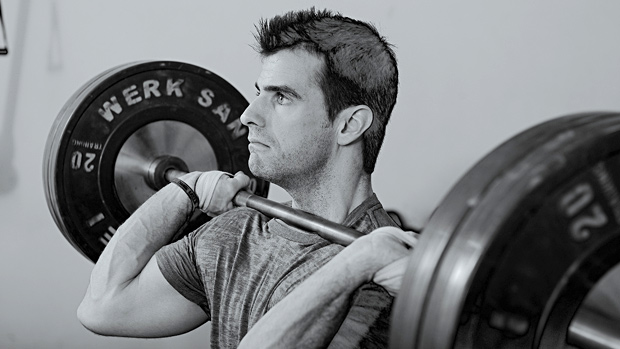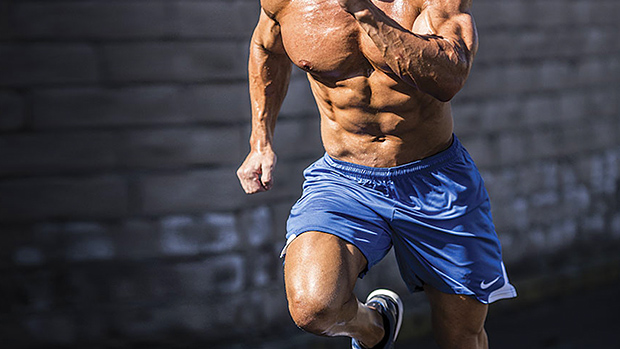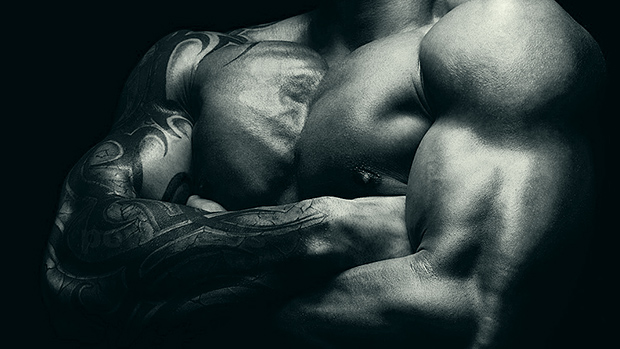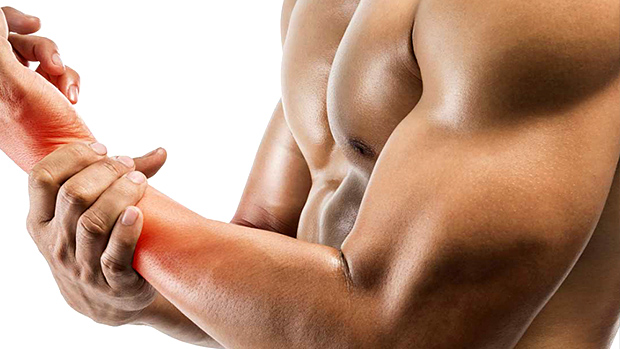The Clean-Grip Reverse Lunge
How would you like to get injured more often and develop some awesome muscular imbalances? Then keep doing only bilateral (two-legged) exercises and avoid all single-leg exercises.
Or you could throw this exercise into your workout program and fix everything:
You'll wipe out your weak points, build more muscle, and be able to squat and deadlift more weight.
1. It Strengthens the Upper Back

Got bad posture? The clean grip used in this exercise can help.
What's often needed is increased upper back strength and thoracic extension - raising your chest, keeping your posture upright. Holding a weight in the clean or front squat position requires you to lift the scapula and clavicle, keeping the elbows elevated and the bar in proper position.
The traps, serratus anterior, levator scapulae, rhomboids, and lats work in unison to hold position and prevent you from dumping the bar forward. The muscles spend lots of time under tension so you improve posture, mobility, and strength, along with adding muscle to your upper back.
Bonus: Being able to maintain thoracic extension will aid your deadlift too, and I know you love you some deadlifts.
2. It Fixes Asymmetries
Most athletes have massive asymmetries from years of heavy lifting, competition, and anatomical differences. Incorporating the clean-grip reverse lunge helps improve hip stability and overall lumbo-pelvic hip function.
Doing the movement requires dynamic stabilization through the trunk and hip, consequently working the quadratus lumborum, adductors, and gluteus - muscles that are nearly always neglected.
This equates to better deadlifts, better squats, and better athletic performance in general.
3. It Builds a Stronger Core
Holding the barbell in front of your body induces a huge anti-flexion response that absolutely scorches the abs.
The longer you maintain position under fatigue and load, the further you separate yourself from the quarter-squatting Smith machine wimps.
4. It Reduces Spinal Stress


Axial loading (loading of the spine) is a key component in building a strong, resilient body, along with overall improvements in bone density, muscle mass, and bad-assery.
But experienced lifters, over time, become less tolerant to the high neurological demands, compressive forces, and in some cases, greater shear forces imposed on the spine.
This can lead to slower recovery, greater risk of acute injury, and greater irritation of chronic injuries.
In the clean-grip reverse lunge, training loads are greatly reduced, at least when compared to heavy bilateral lifts like squats. While compressive stress may be higher during clean-grip reverse lunges because of maintaining a vertical spine, shear stress is greatly reduced, if not eliminated.
This gives your spine and nervous system a break while still destroying (in a good way) your legs, core, and upper back.
5. It's Knee-Friendly
Both compression and shear stress at the knee joint pose problems for some lifters.
The clean-grip reverse lunge uses lighter weights to limit compression. And stepping backward keeps the shin vertical, which limits anterior displacement over the knee, further limiting shear stress on the knee joint.
The exercise gives you better control over the movement of the knee than most single leg and bilateral lower body lifts because you're using lighter weights. As a result, you directly reduce stress at the knee joint while grooving motor control and strength in the muscles that prevent knee varus and valgus.
Proper grip and set-up is vital for sound execution of the exercise. Luckily, you've got a few grip options.
1. Clean Grip

The clean grip is the best option and requires wrapping the fingertips around the bar and keeping the elbows high. This trains the catch position of the clean and provides maximum control.
Wrapping as few as two fingers around the bar is acceptable when the elbows are elevated. It's difficult for many lifters to get in proper position when they haven't learned to use a clean grip. If this is the case, you may need to regress the grip and work on flexibility.
2. Clean Grip With Straps

This grip is similar to the clean grip but uses straps to hold onto the bar. It's a great solution when you have mobility restrictions with the regular clean grip.
3. Bodybuilding Grip

The bodybuilding grip involves resting the bar on the top of the shoulders with hands over the bar and elbows kept high.
This is great for beefcakes with the mobility of a fork, but it sucks for controlling the barbell. Use this grip as a last resort when severe mobility or wrist limitations are present.
Once your grip is set, squat underneath the bar and lift out. Keep the elbows high and chest tall. This keeps the joints stacked and prevents you from dumping forward.
Step back with one foot while dropping the knee and hips towards the ground. Touch the ground lightly with your knee while keeping the toes straight ahead. Return to the standing position with the hips fully extended.
Repeat with the opposite leg to complete the first rep.
Key Cues
- Step back slowly with each rep, controlling the eccentric portion of the lift.
- Keep the feet in line with the hips rather than spreading the feet out wide. A wide stance may lead to pronation of the foot and valgus collapse of the knee, grooving a potentially dangerous movement pattern.
- If balance and loading are problematic, do a goblet-squat reverse lunge.
Clean-grip reverse lunges work best as an accessory movement because you can't go heavy with them easily.
Remember, the main benefits are mobility and stability through the hip, knee, and ankle, in conjunction with building serious single-leg strength so that your big lifts improve.
Use the clean-grip reverse lunge after a main exercise like cleans, squats, or deadlifts because it compliments the muscle groups and movement patterns of all three.
In terms of loading, 135-185 pounds for 3-4 sets of 5-8 reps is plenty for strong lifters to benefit from the exercise.
As an alternative, the clean-grip reverse lunge may be used during a deloading week to reduce axial stress, attack imbalances, and provide a longer time under-tension for muscle growth.




